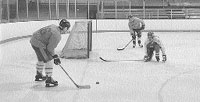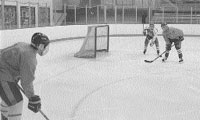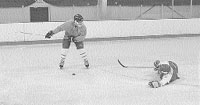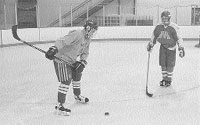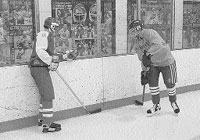| HockeyPlayer.com Defense
This article addresses basic defensive technique you can use as an individual. (See the accompanying sidebar on page 18 for some basic team systems.) The first point to playing defense is understanding the concept. The concept is broken down into a few different propositions: � Defense is for all players not just defensemen. � Playing defense is more than delivering a heavy body check. � A player can be very effective defensively even if the player he is covering does not have the puck. � Consider the goalie as part of your defensive core and include him in your defensive strategy.
Odd man rushes First we�ll discuss individual skills. Perhaps most important defensive skill is being able to defend against an odd man rush. Quite often players make the mistake of thinking that an odd man rush only comes in the form of an end-to-end rush. Not true. Some of the best odd man rushes occur on a 2 on 1 down low near the net. The best strategy when playing a 2 on 1 (or 3 or 4 on 1 for that matter) is to resist attacking the puck carrier. Leave that person to the goalkeeper. Your job as a defenseman is to guard against the pass to another player who might catch your goaltender moving across the crease. Figure 1 illustrates this mistake. The puck carrier might be able to either stick handle around the defender or be able to pass across to his teammate. Under either of those scenarios the result is undesirable. In Figure 2, however, the defender makes an important adjustment. The defender is able to cut off a pass to the puck carrier�s teammate thus forcing the puck carrier to commit to a shot. The defender is also free to clear a rebound, if any. Also, the defender may be able to, at the very last second, attack the puck carrier and force a poor shot.
In front of the net
Blocking shots A critical defensive technique for all players is the ability to block a shot. Unfortunately, although most players mean well when they attempt to block a shot sometimes the effort actually results in the player (the one attempting the block) taking himself out of the play. Figure 5 illustrates the often utilized slide block technique which is not the best choice. The problem with this technique is once you commit to the slide you are committed and now you must block the shot.
Defensive zone forechecking
Quite often puck carriers in your zone will attempt to move the puck either �up boards� or �down boards� depending on their position. Thus, by checking the carrier and by cutting off the passing lane the checker can effectively force the carrier to the inside and also be ready to stick check or body check the carrier. But more importantly, some players instinctively cling to the boards with the puck or they try to pass the puck up or down the boards. By properly executing this checking technique the checker can sometimes gain possession of the puck since the carrier will attempt to slip the puck past the checker along the boards.
Rick Trimble is head coach for the Manasquan High School Varsity team (NJ) and author of the soon to be published book, The Only Ice Hockey Drill Book You�ll Ever Need! Ken Biedzynski is the team�s assistant coach. The authors would like to thank Justin Luna, Andy Trimble and Matthew Fritz for their assistance in demonstrating the techniques. This first appeared in the 03/1997 issue of Hockey
Player Magazine® |
|
|
home
| about us |
sample articles
shop | free
trial | member login
Last Updated: Mar 9th, 2007 - 12:14:39


